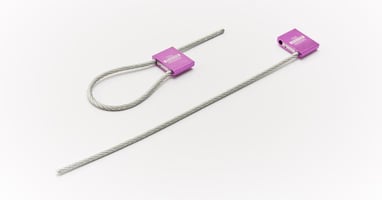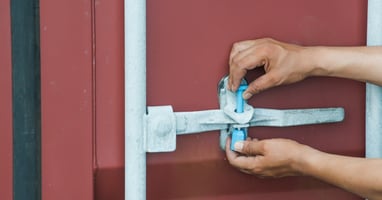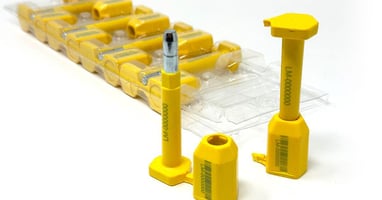Security, efficiency, and protection are critical priorities for industries working with valuable...
What Is a Three-State Seal and How Does It Work?

The safe transport and storage of goods is a concern across many industries. As businesses expand, they face increasing risks associated with theft, tampering, and damage during transit. The consequences of breaches range from financial losses to irreparable damage to ruining a company’s reputation.
Warehouses of all types must have a security system in place to uphold the integrity of the products, and there’s one component that can make a significant difference. Continue reading what three-state seals are and how they work to increase warehouse security.
What Is a Three-State Seal?
Three-state seals feature durable materials. Manufacturers construct the outer casing from high-strength polymers that resist environmental wear and tear, while the internal components often include metal for added security and tamper evidence.
These security seals feature three distinct states. These states are:
- Open: The seal is not applied or has been removed.
- Closed: The seal is properly applied and intact.
- Tampered: The seal shows signs of tampering or damage.
Each state aids in monitoring the security and integrity of goods during transportation and storage. They act as a safeguard against tampering and unauthorized access.
Bolt Lock Seals
Bolt lock seals are suitable for applications that demand maximum security and tamper resistance. Typically constructed from heavy-duty plastic or metal, these seals lock securely into place, forming a formidable barrier. Their locking mechanism, resembling that of a bolt, provides exceptional tensile strength.
Unauthorized removal is extremely challenging, making these seals popular solutions during the transportation and storage of high-value goods such as pharmaceuticals and electronics. They provide a clear indication of tampering for manufacturers and logistics companies alike.
Cable Lock Seals
In contrast, cable lock seals offer remarkable versatility and adaptability for various container shapes and sizes. These seals can conform to a wide range of items. They have durable metal or plastic cables threaded through a locking mechanism that’s ideal for securing everything from truck doors to storage units. They are especially advantageous for handling large or irregularly shaped shipping items, as their adjustable length ensures a snug fit.
The Advantages of Three-State Seals
Securing Shipments
Three-state seals provide exceptional security. They deter unauthorized access and tampering. The visual cue of a sealed shipment alone discourages thieves.
However, the active RFID (Radio Frequency Identification) chip provides an extra layer of protection. Automatic identification alongside continuous monitoring allows the seal to reveal its status with the use of an RFID reader.
In the event of attempted tampering, the seal provides immediate evidence. This security measure is critical for high-value or sensitive shipments. It ensures that products reach their destination unaltered, maintaining customer trust and satisfaction.
Ensuring Product Integrity
Whether your warehouse ships pharmaceutical products, food, or furniture, product integrity is crucial. Three-state seals safeguard the items, ensuring consumers never receive a compromised product.
Tracking Production

Every seal has a unique barcode that you can log and trace. Tracking every shipment streamlines recalls and quality control.
When an issue arises, you can swiftly trace it back to the source and implement corrective measures. This capability is essential for upholding quality assurance.
Inventory Management
Efficient inventory management is another advantage. Seals help monitor stock levels and movement. By recording seal identifiers, you can track products through each stage of the supply chain.
Tracking reduces discrepancies and aids in accurate stock counts. It ensures that your inventory records reflect reality, enabling better decision-making and resource allocation.
Reducing Losses
The financial impact of theft or tampering can be substantial. Implementing three-state seals mitigates these risks by creating a clear deterrent and providing immediate evidence of any tampering. Reducing losses enhances the bottom line, leading to more efficient and profitable operations.
Best Practices for Using Three-State Seals
How To Add Seals to Containers or Trucks
Using three-state seals effectively starts with proper application.
Cable Length
The cable of the 3 State Seal can be manufactured in customized lengths. You have the option of using a smaller cable when securing the seal to a traditional trailer door latch or a longer cable if you need to secure both doors of a container, trailer, or railcar.
Seal Application
Once you select the right cable length, it’s time to apply the seal. Ensure the seal is in a location that is easily visible yet tamper-proof. For containers, affix the seal to the lock mechanism. For trucks, apply it to the rear doors.
Always double-check that the seal is secure. Misapplication can render the seal ineffective and compromise your shipment’s safety.
Data and Seal Documentation
Once the seal is locked, you will use our handheld RFID scanner to complete the first step in the process. Logimate’s custom software solution can capture any of the data you require for your shipment. The initial scan of the seal will record the seal number and document the date, time, and location. By using the scanner, you also have the ability to take a picture of the seal on the trailer/container/railcar. You can reference this image when the shipment arrives to ensure the seal has not changed since its application.
Finally, maintain a record of each seal applied. Document the seal’s unique identifier along with shipment details. This step is crucial for tracking and verifying the integrity of shipments upon arrival.
After the Shipment Arrives
When the shipment arrives at the destination, recipients can scan the seal again to verify it has not been tampered with. The entire seal and cable are wired so that if the circuit breaks at any point during transportation, the event is recorded and will show a tampered warning when the seal is checked. This feature means that even if someone were to cut the cable and have enough time to disguise their tampering efforts, the seal will have recorded that event and let you know the shipment is compromised. You no longer have to rely exclusively on a visible inspection of the seal.
If the shipment arrives and has not been tampered with, you can continue with cutting the seal off and documenting the removal with the handheld scanner.
How To Use RFID Readers
RFID readers allow for quick and efficient scans of seals, facilitating real-time data capture regarding the status and location of shipments.
Create protocols for scanning three-state seals at various checkpoints in your supply chain. Consider establishing these systems during the initial sealing of containers, during transport, and upon arrival at the destination. Ensure that your team is familiar with efficient scanning techniques to minimize delays.
How To Establish Procedures for Employees
Even if you know what three-state seals are and how they work, it doesn’t mean anything unless your employees possess the same knowledge. Demonstrate how to apply the seals, track them, and identify signs of tampering. Routine training sessions conducted at least once a year will ensure new and experienced employees are fully prepared to implement these security seals.
How To Conduct Routine Audits
Routine audits are essential to verify the effectiveness of your sealing procedures. Schedule regular checks to ensure seal applications are correct and records are up to date. Audits can help you identify any gaps in your processes and areas for improvement.
During audits, inspect a random selection of sealed shipments. Check for tampering and verify that the seals match the recorded identifiers. This step guarantees the integrity of your shipments and boosts overall security.
Use audit findings to update procedures and training. Continuous improvement is key to maintaining high standards and minimizing risks.

Choose Three-State Seals From Logimate Today
Companies must ensure that their goods are transported and stored responsibly. Implementing three-state truck seals is the foundation of a trustworthy business.
Logimate caters to the safety of all industries that transport valuable cargo. Whether it’s cash in transit, food and beverages, electronics, or medications, Logimate has the tools to protect the contents of each shipment.
The increased security of three-state seals is why this product is one of our best-selling items. Request a quote today to get the appropriate number of security seals and a customized solution for your needs. Let us know the industry, the product demands, and a rough estimate of the security seals you need to safeguard your business. We have all the tools to make your business a safer, more successful enterprise.




